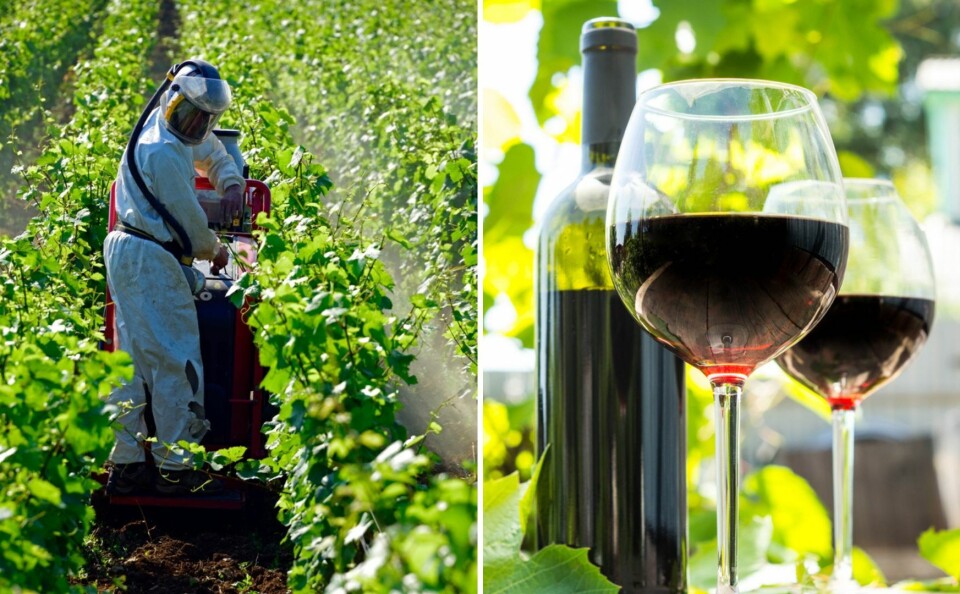-
The origins and meaning of tirer les marrons du feu
As Christmas approaches, we look at a phrase to describe someone who takes advantage of a situation
-
Winegrowers outraged by €0.01 bottle of wine in French supermarket
Lidl claims labelling error but local farmers’ union says it threatens local production
-
Christmas gift ideas for French wine lovers
Our top picks for oenophiles, from decanters to Champagne
Should you be worried about pesticides in French wine?
Vigneron Jonathan Hesford says wine buyers should look beyond the shock headlines

Just before Christmas there was a big scare story published in the Daily Mail and other news outlets across the UK about pesticide residues being found in many ‘high street’ wines.
I’ve seen similar stories published in France and other European countries in recent years so it is not particular to the UK market.
The press releases came from an organisation called the Pesticide Action Network (PAN), whose stated aim is to replace the use of pesticides with alternatives and who advocate for the purchase and use of organic produce.
They have analysed reports made by the UK Government Expert Committee on Pesticide Residues in Food (PRiF), which are available on the gov.uk website.
Read more: MAP: See level of pesticide use in your area of France
What do the campaigners claim?
The two big headline-grabbers were that pesticide mixtures in wine have more than trebled since 2016 and that 50% of wines on the high street contain pesticide residues.
Nick Mole from PAN UK said: “This massive rise in ‘pesticide cocktails’ should be of grave concern because we know that chemicals can become more harmful when combined, and yet we continue to set safety limits for just one chemical at a time.
“Wine lovers shouldn’t have to risk exposure to an array of hazardous pesticides when they fancy a tipple. The organic wine sector is flourishing, proving that it is 100% possible to produce wine without relying on toxic chemicals.”
Read more: France bans pesticide use in more places, including private residences
Reported levels are not at all related to safe limits
Let’s look at that claim of a massive rise in the number of wines with multiple pesticide residues.
In 2016, 13 samples were found to contain more than one pesticide residue out of the 96 samples tested.
In 2023, 36 wines out of 72 were found to contain more than one residue.
At first glance those figures can be construed as increased pesticide usage but there are other factors.
The ability to detect residues improved from 2016 to 2022. Therefore more residues are found above the reporting level. The reporting levels are not at all related to safe limits or acceptable daily intake.
They are the levels at which a laboratory can detect the presence, even in parts per billion, of a particular chemical. That is determined by the equipment and method used as well as the chemical being detected.
Phosphoric acid exists naturally in the environment
Many pesticides break down into other chemicals. For example, Fosetyl Al, a common fungicide used on grapes, breaks down into phosphoric acid. If phosphoric acid is detected, that counts as a pesticide residue.
However, phosphoric acid exists naturally in the environment and the PRiF state that its detection is not proof that a pesticide has been used.
Sustainable viticulture and other environmental farming programmes encourage the use of different pesticides during the year in order to prevent resistance evolving in the disease being treated.
Therefore it is not surprising that the number of wines with multiple pesticide residues has increased. It shows an improvement in viticultural practice from simply spraying the same pesticide repeatedly.
Read more: Winemakers face new problems each year due to climate change in France
Experts do look at effects of combining pesticides
The PRiF do consider the ‘cocktail effect’ of multiple pesticides. It is not true that they only set safety limits for one chemical at a time.
They do additional risk analysis in a much more scientific way than the PAN view that ‘chemicals can become more harmful when combined’.
They look at the family of chemicals that the pesticide belongs to and at studies that have been done on the combination of pesticides as a risk to health.
Not one wine was over the Maximum Residue Level
Now let’s turn to the second claim that 50% of the wines on the high street contain dangerous toxins.
In 2016, 24 of the 96 samples had detectable pesticide residues. In 2022, it was 48 out of 72.
Again, that increase may well be influenced by improvements in detection equipment and methods.
These types of stories always focus on the number of different pesticide residues found and purposely ignore the amounts detected.
Paracelsus laid down the fundamental principle of toxins way back in the sixteenth century. Sola dosis facit venenum (Only the dose makes the poison).
We all know that consuming too much of certain chemicals will do us harm but that we can live perfectly healthy lives if we consume them in limited quantities.
The same applies to pesticide residues as it does to bacteria, minerals and drugs – such as alcohol.
The most important thing is not the number of wines found to have a detectable pesticide residue, nor the number of wines found to have multiple pesticide residues.
It is the number of wines that contain residues above the Maximum Residue Level (MRL).
Not a single wine tested in the survey was found to contain any residues above the MRL.
Read more: Pesticides in French tap water ‘not a health risk’
Expert committee found no health issues
The official report explains that “MRLs are not in themselves safety limits, an exposure to residues in excess of an MRL does not automatically imply a hazard to health.”
MRLs reflect levels of pesticides that could occur in produce which has been treated in accordance with good agricultural practice, and those levels are always below the safety limit of Acceptable Daily Intake – which itself is the level at which one can consume a chemical, every single day of ones life, in the certainty that no harm will result.
The conclusion of the Expert Committee is quite different to that of PAN. They state that ‘Residues detected would not be expected to have an effect on health’.
Misleading pesticide claims used to boost organic sales
Despite a large increase in sales of organic wine, especially among younger people, organic lobbyists and activists have struggled to convince the majority of consumers that organic farming is really better for the environment.
Concerns over the increased amount of fossil fuels used and the inefficiency of land and water-use balance out the arguments for organic farming and even PAN admits that many non-organic farmers are doing great things for the environment.
The big benefit they claim for organic methods is “a greater diversity of weeds and other plants which provide habitat and food for birds, bees and other farmland species.”
They also admit that there are no reliable studies that suggest eating organic food has any intrinsic health benefits.
Therefore they are left with one issue to encourage consumers to choose organic wine and food (which often means spending more money) and that is the presence of scary pesticide residues.
However, what they didn’t mention in their analysis is that four out of the seven samples of organic oats tested, and two of the organic potato samples tested, also contained synthetic pesticide residues.
Finally, it is worth mentioning that the kind of mass-produced wines selected for testing in these kinds of surveys are less likely to be following the best environmental practices in their vineyards than wines made by smaller, more quality-focused estates.
Related articles
What is the future of organic wine in France and do consumers care?
French minister calls new 10-year glyphosate authorisation ‘stupidity’
How to check the green credentials of products in French supermarkets























